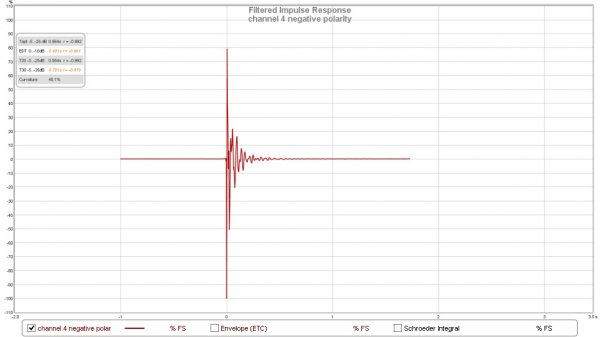That's what I figured and it is the same paper I referenced. I think it has two titles depending the review of the paper.I was referring to a third one, Low-Frequency Optimization Using Multiple Subwoofers, which describes the SFM algorithm, at least how they conceived of it at the time.
Destructively Driving Modes
- Thread starter dallasjustice
- Start date
You are using an out of date browser. It may not display this or other websites correctly.
You should upgrade or use an alternative browser.
You should upgrade or use an alternative browser.
Yes, I think it may be AES convention presentation vs. final article. I don't have AES access so I can't check it. The one I referenced was made available freely by them for a time, but it looks like it's behind a paywall again.
Taking it one step further, and assuming a rectangular room, if you were to place one sub in a corner and an out-of-phase sub in the diagonally opposite corner (ceiling mount), you could in theory kill multiple resonances.
Ooops - of course, the two subs have to be in phase, not out of phase. As someone pointed out, there might be a phase difference between Michael's two subs.
A ripple tank is a good learning aid:
http://www.falstad.com/ripple/
It's a Java app. You can run it on the Web page, or download the app.
Ooops - of course, the two subs have to be in phase, not out of phase. As someone pointed out, there might be a phase difference between Michael's two subs.
A ripple tank is a good learning aid:
http://www.falstad.com/ripple/
It's a Java app. You can run it on the Web page, or download the app.
I'm exonerated!


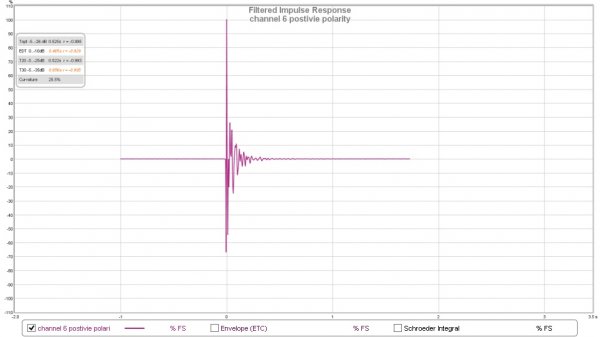
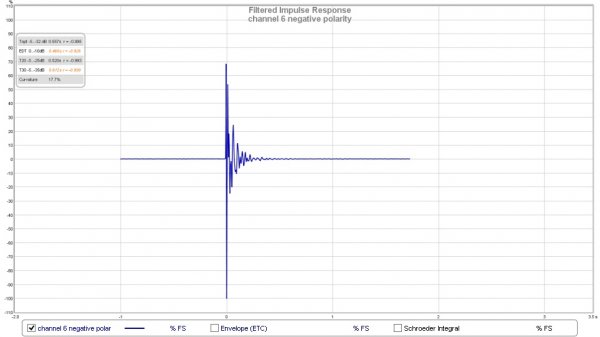
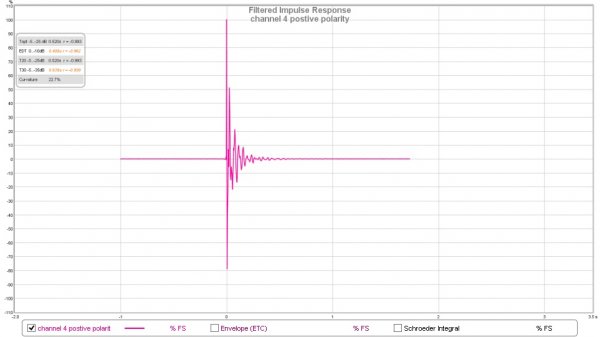
Sink
I experimented by turning the front subs down by 9db in the mixer. Now the result is even smoother.
I think this is cool stuff because I am not using any DSP, delay or EQ. This is just front two subs in positive polarity and rear subs in negative polarity. I set the rears to 45 degrees phase to account for the "source" flight time to rear wall "sink" woofers. The following shows the difference between four subs and one sub setup in this way.
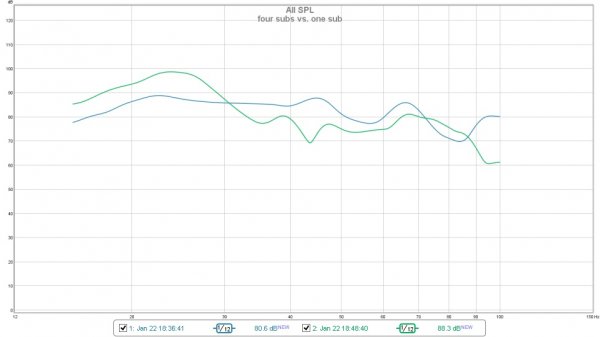
if you play a sine wave at the cancellation frequency you turn the volume UP on the rear sub and the SPL decreases at the modal frequency. Very cool stuff.
I experimented by turning the front subs down by 9db in the mixer. Now the result is even smoother.
I think this is cool stuff because I am not using any DSP, delay or EQ. This is just front two subs in positive polarity and rear subs in negative polarity. I set the rears to 45 degrees phase to account for the "source" flight time to rear wall "sink" woofers. The following shows the difference between four subs and one sub setup in this way.

Last edited:
I use 4 SVS subs with my g1's.. 3 at midwall position and one in a corner elevated to about 1m off the floor
the corner one is out of phase.
They are low passed at 80hz , speakers arent low passed at all.
I use a Meridian 568.2 processor to act as a master controller as to volume , delays and so on
I then use DIRAC to tidy things up
The end result is stunning bass at listening position and just about all places in the room.
the subs Im using are total overkill..they run at idle...
the corner one is out of phase.
They are low passed at 80hz , speakers arent low passed at all.
I use a Meridian 568.2 processor to act as a master controller as to volume , delays and so on
I then use DIRAC to tidy things up
The end result is stunning bass at listening position and just about all places in the room.
the subs Im using are total overkill..they run at idle...
I experimented by turning the front subs down by 9db in the mixer. Now the result is even smoother.
I think this is cool stuff because I am not using any DSP, delay or EQ. This is just front two subs in positive polarity and rear subs in negative polarity. I set the rears to 45 degrees phase to account for the fact they are slightly closer to the MLP. The following shows the difference between four subs and one sub setup in this way.
So finally you realize digital delay is not necessary to get good response for a subwoofer array, like I have been telling you for years? The only delay that is really critical is the ability to delay the mains relative to the sub array.
It's interesting that there are multiple approaches to how to deal with the sub array. You can do source/sink, or you can run all in phase and get odd order cancellation/even order boost, or you can add some delay or phase shift to some of the subs to move the standing wave around the room (e.g. null points in a 1st axial), or you can adjust the level of subs to change the standing wave pattern.
..as to which one sounds best, well that is an interesting question. Does a maximally flat alignment trump a maximally phase coherent response? How does the ear/brain perception of music differ from a swept sine or steady state stimulus?
I really think the fazenda paper is most interesting. They compared an EQ'd subwoofer against the so called "Welti optimized". Welti optimized is a 2 sub midwall setup, a "Welti" configuration. The "optimized" or "active" aspect to "Welti optimized" was how they used the CABS method or "source" and "sink." That is, fazenda used the front wall sub as the "source" the the rear wall sub in anti-phase as the "sink." I've done this myself in my room.
The fazenda study concluded that listeners preferred the MUCH cleaner decay times heard with the "Welti optimized" system versus the flatter EQ'd system and the traditional midwall Welti setup. Of course, we don't need to choose one or the other. We can have both, right?

The fazenda study concluded that listeners preferred the MUCH cleaner decay times heard with the "Welti optimized" system versus the flatter EQ'd system and the traditional midwall Welti setup. Of course, we don't need to choose one or the other. We can have both, right?

So finally you realize digital delay is not necessary to get good response for a subwoofer array, like I have been telling you for years? The only delay that is really critical is the ability to delay the mains relative to the sub array.
It's interesting that there are multiple approaches to how to deal with the sub array. You can do source/sink, or you can run all in phase and get odd order cancellation/even order boost, or you can add some delay or phase shift to some of the subs to move the standing wave around the room (e.g. null points in a 1st axial), or you can adjust the level of subs to change the standing wave pattern.
..as to which one sounds best, well that is an interesting question. Does a maximally flat alignment trump a maximally phase coherent response? How does the ear/brain perception of music differ from a swept sine or steady state stimulus?
Last edited:
What is the configuration of your room? A rectangle or something else?So, where should I put the ****** things then?
Keith
I am wearing two as headphones, but seriously rectangular ,I am interested because I am about to start a M/C experiment , when the speakers eventually arrive!What is the configuration of your room? A rectangle or something else?
VB Keith.
Thanks A I will ,I will do some measuring and report back, obviously I am hoping to swept along on your ( and Mikes ) coat tails.Good. Get the first two. Put them in opposing middle walls and see how they work.
BW Keith.
Amir, Nyal,
That too is true, but Welti in his paper AES 5602 drives the subwoofers in-phase so that for cancellation of a particular mode the subs have to be placed in locations of equal magnitude and opposite phase of that mode. The setup with two subs midpoint front and rear walls scores among the best in the virtual room, the very same setup only scores 6th place in Fazenda’s single-listening-position listening tests, whereas in the latter tests the setups with source-to-sink configurations score best.
I wouldn't say that! I'm still struggling to understand what exactly happens to an air molecule when it hits the wall. You have standing waves at all frequencies, but modes only at particular ones, why exactly is that the case and how do the wave trains travelling towards both walls look like? Many questions. But thanks for the kind words!
I don’t have the possibility to place subwoofers in our living room so my interest in this particular topic is limited, therefore I did not read all of those papers on subs thoroughly. The chapter “Bass and room modes” is still on my to-do list, and the pile of papers is waiting to be explored.
That is the million-dollar question. People optimize their setups using theoretical considerations or models and test signals and a mike. When you look at, for instance, perception thresholds, the differences between those for test signals and those for speech or music can be quite substantial. That’s why different configurations of acoustic room treatments or subwoofers or electronic “room correction” should be evaluated and compared by appropriate listening tests using music, obviously with adequate control of the test parameters. Remember what J. Gordon Holt said about the listener:
"The listener is the heart of the high-fidelity system, and is noted for having high distortion, poor frequency response, marginal stability, and arbitrarily variable performance characteristics."
It's those last two characteristics that make controls an absolute must.
Klaus
That is true but the principal of mode cancellation works just as well for one seat or we would lose the sweet spot in such optimizations.
That too is true, but Welti in his paper AES 5602 drives the subwoofers in-phase so that for cancellation of a particular mode the subs have to be placed in locations of equal magnitude and opposite phase of that mode. The setup with two subs midpoint front and rear walls scores among the best in the virtual room, the very same setup only scores 6th place in Fazenda’s single-listening-position listening tests, whereas in the latter tests the setups with source-to-sink configurations score best.
If there is someone who can give me a run for my money on these topics, it is you!
I wouldn't say that! I'm still struggling to understand what exactly happens to an air molecule when it hits the wall. You have standing waves at all frequencies, but modes only at particular ones, why exactly is that the case and how do the wave trains travelling towards both walls look like? Many questions. But thanks for the kind words!
I don’t have the possibility to place subwoofers in our living room so my interest in this particular topic is limited, therefore I did not read all of those papers on subs thoroughly. The chapter “Bass and room modes” is still on my to-do list, and the pile of papers is waiting to be explored.
..as to which one sounds best, well that is an interesting question. Does a maximally flat alignment trump a maximally phase coherent response? How does the ear/brain perception of music differ from a swept sine or steady state stimulus?
That is the million-dollar question. People optimize their setups using theoretical considerations or models and test signals and a mike. When you look at, for instance, perception thresholds, the differences between those for test signals and those for speech or music can be quite substantial. That’s why different configurations of acoustic room treatments or subwoofers or electronic “room correction” should be evaluated and compared by appropriate listening tests using music, obviously with adequate control of the test parameters. Remember what J. Gordon Holt said about the listener:
"The listener is the heart of the high-fidelity system, and is noted for having high distortion, poor frequency response, marginal stability, and arbitrarily variable performance characteristics."
It's those last two characteristics that make controls an absolute must.
Klaus
So, where should I put the ****** things then?
Keith
I guess the key take away for me is that it is best to optimally arrange and set the subs up. The second step is EQ. I've known this for a while but I'm still learning about ways to go back to step one and improve upon the setup since it appears that the setup may be much more important than the EQ.
You have to tweak by ear as well as a hump here or there doesnt hurt what you hear... I like my bass prominent so long as its clean and crisp
Similar threads
- Replies
- 24
- Views
- 267
- Replies
- 4
- Views
- 296
- Replies
- 8
- Views
- 661
- Replies
- 6
- Views
- 471
| Steve Williams Site Founder | Site Owner | Administrator | Ron Resnick Site Owner | Administrator | Julian (The Fixer) Website Build | Marketing Managersing |


